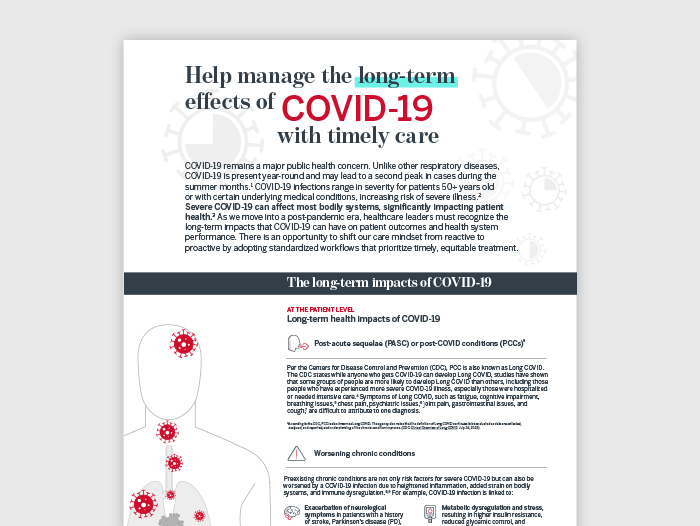Auto logout in seconds.
Continue LogoutAs COVID-19 cases and hospitalizations increase in the United States, a new omicron subvariant, EB.5.1 or "Eris," is quickly gaining prevalence due to mutations that make it "a little bit more slippery" and "competitive" than other circulating variants.
COVID-19 cases are on the rise
According to the World Health Organization (WHO), over 1 million new COVID-19 cases and over 3,100 deaths were reported in the last 28 days up to Aug. 3. The United States has also seen a rise in cases over the last few weeks, with the highest increases in the Northeast and South, then the West and Midwest.
As of last week, COVID-19 test positivity rates were 7.6%, a level that was last seen in the summer of 2021, just before the delta variant spread across the country, and November 2021.
"We have had a summer wave of COVID for the last few summers and so it's not surprising to see an increase in COVID right now," said Jill Rosenthal, director of public health policy at the Center for American Progress.
For the week ending July 29, there were 9,056 new COVID-19 hospitalizations nationwide, a 12.5% increase from the week before, according to CDC data. Currently, 14 counties in the United States are considered to have "medium" levels of COVID-19 hospitalization, reaching between 10 and 19.9 admissions per 100,000 people.
According to Eric Sztejman, a pulmonologist at Virtua Health, the current increase in COVID-19 cases and hospitalizations may be partly due to more people staying inside from the heat this summer.
"When it gets really hot, people go indoors, when it gets really cold, people go indoors, and when you're inside the ventilation is different, people are closer together. So I think that's part of it," said David Wohl, an infectious disease physician.
A new COVID-19 subvariant is growing in prevalence
As COVID-19 cases and hospitalizations increase, WHO is keeping an eye on a new omicron subvariant, EG.5.1, that has been gaining traction in several countries, including the United Kingdom and the United States.
The EG.5.1 variant, which has been unofficially nicknamed "Eris," has been designated as one of the "variants under monitoring" by WHO, but is not currently considered a variant of interest or concern.
As of July 20, EG.5.1 was the second most common variant infecting people in the United Kingdom, making up around 14.55% of cases with a 20.51% weekly growth rate. According to the U.K. Health Security Agency, there was a 40.7% increase in COVID-19 hospitalizations for the week ending July 29 compared to the week prior.
In the United States, EG.5.1 has become the most prevalent COVID-19 variant, making up 17.3% of cases for the two-week period ending Aug. 5. The most common variants after EG.5.1 are XBB.1.16 (15.6%), XBB.2.23 (11.2%), and XBB.1.5 (10.3%).
According to Stuart Turville, an associate professor at the University of New South Wales in Sydney, the EG.5 group of subvariants is "a little bit more slippery" and "competitive" compared to other current variants and is able to "navigate better the presence of antibodies" from vaccines.
However, he noted that EG.5 is only slightly different from other circulating subvariants, mostly because it evolved to "give it a better ability to engage and enter cells a little bit better."
K. Srinath Reddy from the Public Health Foundation of India noted that while EG.5 is more infectious than other subvariants, it is not more virulent, and its "impact on the human body is just about the same."
According to the Zoe Health Study, which monitors and estimates COVID-19 cases in the United Kingdom, EG.5.1 generally has similar symptoms to omicron. The most common EG.5.1 symptoms include a runny or stuffy noise, headache, fatigue, sneezing, sore throat, coughing, and smell changes.
"It's clear we're going to be seeing this particular variant have its own day in the sun or period of dominance for some time before it's replaced by yet another variant," Reddy said. "That's the nature of the virus."
Overall, WHO said that COVID-19 "remains a major threat" and that it "continues to urge Member States to maintain, not dismantle, their established COVID-19 infrastructure. It is crucial to sustain surveillance and reporting, variant tracking, early clinical care provision."
According to Turville, it's understandable people want to put the pandemic behind them, but COVID-19 is a "virus we live with now," like influenza, and requires regular monitoring. "We are still working in the background, even if it's not front page news," he said. (Tin, CBS News, 8/7; Walrath-Holdridge, USA Today, 8/7; Moon et al., Washington Post, 8/8)
As case counts increase across the country rise as a result of COVID-19, hospitals and health systems already strained by staffing shortages must be ready to confront the challenges at stake. Access the collection of our best resources and insights for creating capacity, supporting staff, communicating with patients, and more.
Don't miss out on the latest Advisory Board insights
Create your free account to access 1 resource, including the latest research and webinars.
Want access without creating an account?
You have 1 free members-only resource remaining this month.
1 free members-only resources remaining
1 free members-only resources remaining
You've reached your limit of free insights
Become a member to access all of Advisory Board's resources, events, and experts
Never miss out on the latest innovative health care content tailored to you.
Benefits include:
You've reached your limit of free insights
Become a member to access all of Advisory Board's resources, events, and experts
Never miss out on the latest innovative health care content tailored to you.
Benefits include:
This content is available through your Curated Research partnership with Advisory Board. Click on ‘view this resource’ to read the full piece
Email ask@advisory.com to learn more
Click on ‘Become a Member’ to learn about the benefits of a Full-Access partnership with Advisory Board
Never miss out on the latest innovative health care content tailored to you.
Benefits Include:
This is for members only. Learn more.
Click on ‘Become a Member’ to learn about the benefits of a Full-Access partnership with Advisory Board
Never miss out on the latest innovative health care content tailored to you.


